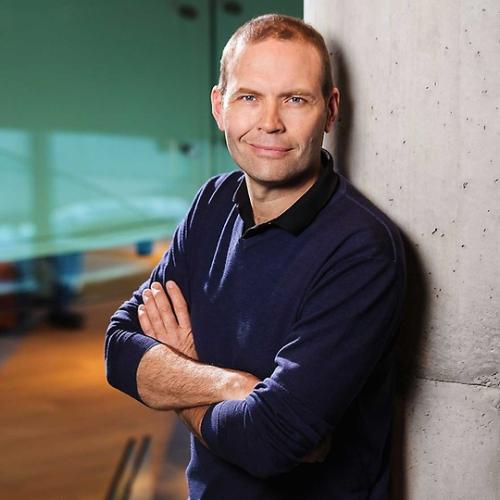
Nils Jaeger
Nils Jaeger is President of Volvo Autonomous Solutions and a Member of the Group Management of Volvo Group, reporting directly to CEO Martin Lundstedt. Previously, Nils was President of Volvo Financial Services EMEA and, prior thereto, several management positions within Deere & Company.

Fiona Tan
Fiona Tan is Wayfair’s Chief Technology Officer, and oversees a global innovation team responsible for creating market-leading experiences through its world-class e-commerce platform. Prior to Wayfair, Fiona served as senior vice president of U.S. Technology at Walmart where she was responsible for innovation and engineering execution spanning its site, mobile app and all associate and merchant-facing technology across its e-commerce and stores business in the U.S. Her prior roles at Walmart include senior vice president of Customer Technology and vice president of Engineering. Prior to Walmart, Fiona served in a number of leadership roles at Ariba, where she led a global engineering organization responsible for the strategy, lifecycle, and delivery of the Ariba Commerce Network, as well as TIBCO Software. Fiona has a master’s degree in Computer Science from Stanford and a bachelor’s degree in Computer Science and Engineering from MIT.

Jeetu Patel
Jeetu Patel is Cisco’s President and Chief Product Officer. He combines a bold vision, steeped in product design and development expertise, operational rigor, and innate market understanding to create high growth businesses. He is relentlessly focused on building world class products that solve Cisco customers’ biggest problems—bringing the power of the Cisco portfolio together to connect and protect every aspect of their organization in the era of AI.
Previously he was Cisco’s Executive Vice President and General Manager of Security and Collaboration where he led the strategy and development for these businesses and held P&L responsibility for the multibillion-dollar portfolio. In this role, Jeetu led with his creative vision and intense focus on innovation and swift execution. Together with his team, he transformed and positioned our Security and Collaboration portfolios for success and growth. In both areas, he reinvigorated organic innovation, championed key inorganic investments, and drove simplification across these portfolios with a fanatical focus on design and user experience.
Prior to joining Cisco in 2020, Jeetu was the Chief Product Officer (CPO) and Chief Strategy Officer (CSO) at Box, a role he pioneered. He led the company’s product and platform strategy, setting the company’s long-term vision and roadmap for cloud content management in the enterprise. He transformed Box from a single product application to a multi-product platform used by 100K customers representing 69% of the Fortune 500. The discipline, quality standards, performance metrics, and stability Jeetu instilled fueled the platform’s growth – nearly quadrupling revenues to $700M+. Box’s growth scaled to reach over 60M users with over 50% of customers using multiple products. He also created the Box Platform business unit where he led product strategy, marketing and developer relations – driving products from incubation stage to mature offerings.
Before joining Box, Jeetu was General Manager and Chief Executive of EMC’s newly acquired Syncplicity business unit, a cloud service for Enterprise File Sync Sharing (EFSS) and collaboration. One of the first SaaS-based solutions offered by EMC, Jeetu spearheaded the company’s acquisition. He created a world class leadership team, secured some of the market’s largest customers and led the group to become one of the fastest growing EFSS companies in a highly competitive market. Other key roles at EMC included CMO for the Information Intelligence Group and Chief Strategy Officer, where he drove the organic and inorganic strategy for the division’s cloud and mobile growth.
Previously, Jeetu was President of Doculabs, a research and advisory firm co-owned by Forrester Research. The firm focused on collaboration and content management across a range of industries including financial services, insurance, energy, manufacturing, and life sciences.

Magnus Östberg
Magnus Östberg is the Chief Software Officer (CSO) at Mercedes-Benz, where he spearheads the development and implementation of the MB.OS vehicle operating system. Born in Sweden, Östberg holds a Master's degree in Electrical Engineering from Chalmers University of Technology and an Executive MBA from the University of Gothenburg. With a career deeply rooted in automotive software, Östberg brings extensive experience from leadership roles at Mecel, Delphi, and Aptiv. His expertise spans vehicle software, infotainment, telematics, and advanced driver-assistance systems (ADAS). Notably, at Aptiv, he was instrumental in the development and launch of the ADAS Satellite Architecture for multiple automotive manufacturers.

Sastry Durvasula
Sastry Durvasula is the Chief Operating, Information and Digital Officer at TIAA, responsible for powering the enterprise’s business growth, scaling innovation and client impact, driving operational excellence, and accelerating TIAA’s transformation. In his role, Sastry drives operating strategies and enterprise-wide capabilities in alignment with the company’s strategic goals through four connected pillars he oversees globally: Technology, Digital & Client Experience, Operations and Shared Services. He is a member of the company’s Executive Committee.
Sastry’s responsibilities also include Business Operational Effectiveness, Enterprise Data, Analytics and AI, Client Tech Labs and Strategic Partnerships across Retirement Services, Nuveen Asset Management and Wealth Management, and serving on the board of TIAA Global Capabilities in India. Previously he served as TIAA’s Chief Information and Client Services Officer, a role he held upon joining the firm in February 2022.
Sastry’s recent accomplishments include – leapfrogging TIAA’s technology, digital and data ecosystem to a modern cloud-based stack, launching the company’s GenAI platform TIAA gAItSM, forging strategic partnerships to transform recordkeeping and FinTech investments and incubation through TIAA Ventures. Sastry and team also built and rolled out an award-winning, global Guild Network and Guild Gigs to upskill/reskill colleagues and foster a learning culture, that includes an AI Guild with several thousand active members.
Previously, Sastry served as the Global Chief Technology and Digital Officer, and Partner, at McKinsey & Company. In that role, he led the strategy and development of the firm’s differentiating digital products and platforms, internal and client-facing technology, data & analytics, AI/ML, cyber and hybrid cloud ecosystem, and served as a senior advisor on client engagements.
He also held Chief Digital Officer, Chief Data & Analytics, CIO and global technology leadership roles at insurance broker and risk management company Marsh and at American Express, where he spent 15 years. He was also a consultant for several Fortune Global 500 companies.
Sastry brings a breadth of global experience in the technology, financial services, payments and insurance domains, and a proven track record in leading and transforming large organizations, shaping innovative digital strategies and experiences, driving complex risk, regulatory and cyber security capabilities, and managing global P&Ls. He successfully led the development of strategic B2C, B2B and B2B2C products and platforms, FinTech and InsurTech partnerships, digital labs, M&A and new ventures.
Sastry is a passionate advocate for diversity and sustainability. He is the executive co-sponsor of Achieve, TIAA’s Business Resource Group advancing women, executive ambassador of TIAA’s Sustainability Action Team, served on the board of Girls in Tech, and has championed industry-wide initiatives focused on women in tech, including ReWRITE and Half the Board.
Sastry holds a master’s degree in engineering from the Indian Institute of Science, is credited with 40+ patents and plays a leadership role in technology industry/academia consortia. He is a lifelong learner, a recognized speaker and influencer, and recipient of several honors and industry awards, including Future Enterprise North America Awards CIO of Year, by the International Data Corporation (IDC) and an Outstanding 50 Asian Americans in Business Awards honoree, by the Asian American Business Development Center (AABDC).

Dave Cooney
David Cooney is the Head of GTM strategy at HelixAI and former Strategic Client Partner at Causaly AI and former Associate Partner at McKinsey, focused on AI in life sciences R&D. He has led GTM strategy, value proposition design, and enterprise partnerships across top-20 pharma, building multimillion-dollar pipelines and shaping AI product-packaging and partnership

Carl Latham

Joseph Pearson

